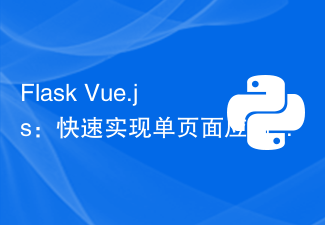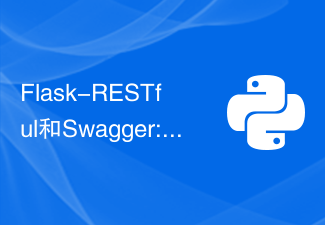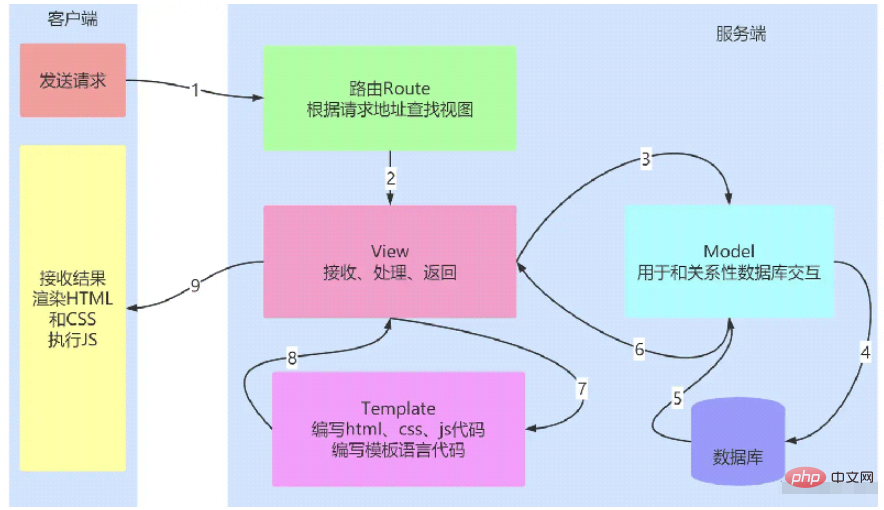 Backend Development
Backend Development Python Tutorial
Python Tutorial Learn how to install the Flask framework on your system: The simple steps to install the Flask framework
Learn how to install the Flask framework on your system: The simple steps to install the Flask framework
Flask Framework Installation Guide: Easy to get started with the installation method of Flask framework, specific code examples are required
Introduction:
Flask is a lightweight web application Framework, developed based on Python. It is easy to learn and powerful, suitable for rapid development of small or medium-sized web applications. This article will introduce how to install the Flask framework and provide specific code examples to help readers easily install the Flask framework.
1. Preparation
Before starting to install the Flask framework, we need to ensure that the Python environment has been installed in the system. If Python is not installed on your system, please install Python first.
2. Install the Flask framework
The installation of the Flask framework is very simple and can be installed through the Python package management tool pip. Enter the following command in the console or terminal to install the Flask framework:
pip install flask
The system will automatically download and install the latest version of the Flask framework.
3. Verify installation
After the installation is completed, we can verify whether the Flask framework is successfully installed through a simple sample code. Create a Python file named app.py. The code in the file is as follows:
from flask import Flask
app = Flask(__name__)
@app.route('/')
def hello_world():
return 'Hello, Flask!'
if __name__ == '__main__':
app.run()Execute the following command to start the Flask application:
python app.py
Enter # in the browser ##http://localhost:5000/, if you see "Hello, Flask!" displayed on the page, it means that the Flask framework has been successfully installed and running.
In actual development, we may need to perform some configurations on the Flask application. For example, modify the application host and port number, set debugging mode, etc. Flask provides a configuration file
config.py, which we can modify to configure the Flask application. The following is a simple configuration file example:
DEBUG = True HOST = '0.0.0.0' PORT = 5000Import the configuration file in
app.py and modify the application configuration:
from flask import Flask
from config import *
app = Flask(__name__)
app.config.from_object(__name__)
@app.route('/')
def hello_world():
return 'Hello, Flask!'
if __name__ == '__main__':
app.run(host=HOST, port=PORT, debug=DEBUG)Run app. py file, the Flask application will be started according to the settings in the configuration file.
This article introduces the installation method of the Flask framework and provides specific code examples. By referring to this article, readers can easily install and run the Flask framework, laying the foundation for subsequent development of web applications.
The above is the detailed content of Learn how to install the Flask framework on your system: The simple steps to install the Flask framework. For more information, please follow other related articles on the PHP Chinese website!
 Flask + Vue.js:快速实现单页面应用Jun 17, 2023 am 09:06 AM
Flask + Vue.js:快速实现单页面应用Jun 17, 2023 am 09:06 AM随着移动互联网和Web技术的迅速发展,越来越多的应用需要提供流畅、快速的用户体验。传统的多页面应用已经无法满足这些需求,而单页面应用(SPA)则成为了解决方案之一。那么,如何快速实现单页面应用呢?本文将介绍如何利用Flask和Vue.js来构建SPA。Flask是一个使用Python语言编写的轻量级Web应用框架,它的优点是灵活、易扩
 如何使用python+Flask实现日志在web网页实时更新显示May 17, 2023 am 11:07 AM
如何使用python+Flask实现日志在web网页实时更新显示May 17, 2023 am 11:07 AM一、日志输出到文件使用模块:logging可以生成自定义等级日志,可以输出日志到指定路径日志等级:debug(调试日志)=5){clearTimeout(time)//如果连续10次获取的都是空日志清除定时任务}return}if(data.log_type==2){//如果获取到新日志for(i=0;i
 Flask和Intellij IDEA集成: Python web应用程序开发技巧(第二部分)Jun 17, 2023 pm 01:58 PM
Flask和Intellij IDEA集成: Python web应用程序开发技巧(第二部分)Jun 17, 2023 pm 01:58 PM在第一部分介绍了基本的Flask和IntellijIDEA集成、项目和虚拟环境的设置、依赖安装等方面的内容。接下来我们将继续探讨更多的Pythonweb应用程序开发技巧,构建更高效的工作环境:使用FlaskBlueprintsFlaskBlueprints允许您组织应用程序代码以便于管理和维护。Blueprint是一个Python模块,能够包
 Flask-RESTful和Swagger: Python web应用程序中构建RESTful API的最佳实践(第二部分)Jun 17, 2023 am 10:39 AM
Flask-RESTful和Swagger: Python web应用程序中构建RESTful API的最佳实践(第二部分)Jun 17, 2023 am 10:39 AMFlask-RESTful和Swagger:Pythonweb应用程序中构建RESTfulAPI的最佳实践(第二部分)在上一篇文章中,我们探讨了如何使用Flask-RESTful和Swagger来构建RESTfulAPI的最佳实践。我们介绍了Flask-RESTful框架的基础知识,并展示了如何使用Swagger来构建RESTfulAPI的文档。本
 Flask和Sublime Text集成: Python web应用程序开发技巧(第六部分)Jun 17, 2023 pm 04:08 PM
Flask和Sublime Text集成: Python web应用程序开发技巧(第六部分)Jun 17, 2023 pm 04:08 PMFlask和SublimeText集成:Pythonweb应用程序开发技巧(第六部分)SublimeText和Flask都是Pythonweb应用程序开发中的重要工具。然而,如何将二者集成起来,使得开发过程更加高效呢?本文将介绍一些SublimeText的插件和配置技巧,帮助你更方便地开发Flask应用程序。一、安装SublimeText插件F
 Flask-Security: 在Python web应用程序中添加用户身份验证和密码加密Jun 17, 2023 pm 02:28 PM
Flask-Security: 在Python web应用程序中添加用户身份验证和密码加密Jun 17, 2023 pm 02:28 PMFlask-Security:在Pythonweb应用程序中添加用户身份验证和密码加密随着互联网的不断发展,越来越多的应用程序需要用户身份验证和密码加密来保护用户数据的安全性。而在Python语言中,有一个非常流行的Web框架——Flask。Flask-Security是基于Flask框架的一个扩展库,它可以帮助开发人员在Pythonweb应用程序中轻
 Flask和Eclipse集成: Python web应用程序开发技巧(第三部分)Jun 17, 2023 pm 03:27 PM
Flask和Eclipse集成: Python web应用程序开发技巧(第三部分)Jun 17, 2023 pm 03:27 PMFlask和Eclipse集成:Pythonweb应用程序开发技巧(第三部分)在前两篇文章中,我们介绍了如何将Flask与Eclipse集成,以及如何创建Flask应用程序。在本文中,我们将继续探讨如何开发和调试Flask应用程序,以及如何管理数据库。一、开发和调试Flask应用程序创建和运行Flask应用程序在Eclipse的ProjectExplo
 Python Flask JinJa2语法如何使用May 16, 2023 am 09:19 AM
Python Flask JinJa2语法如何使用May 16, 2023 am 09:19 AM一、概述Flask是一个轻量级的PythonWeb框架,支持Jinja2模板引擎。Jinja2是一个流行的Python模板引擎,它可以使用Flask来创建动态Web应用程序。web页面一般需要html、css和js,可能最开始学习pythonweb的时候可能这样写:fromflaskimportFlaskapp=Flask(__name__)@app.route('/')defhello():return'hellohelloworld!!!&am


Hot AI Tools

Undresser.AI Undress
AI-powered app for creating realistic nude photos

AI Clothes Remover
Online AI tool for removing clothes from photos.

Undress AI Tool
Undress images for free

Clothoff.io
AI clothes remover

AI Hentai Generator
Generate AI Hentai for free.

Hot Article

Hot Tools

Dreamweaver Mac version
Visual web development tools

MinGW - Minimalist GNU for Windows
This project is in the process of being migrated to osdn.net/projects/mingw, you can continue to follow us there. MinGW: A native Windows port of the GNU Compiler Collection (GCC), freely distributable import libraries and header files for building native Windows applications; includes extensions to the MSVC runtime to support C99 functionality. All MinGW software can run on 64-bit Windows platforms.

MantisBT
Mantis is an easy-to-deploy web-based defect tracking tool designed to aid in product defect tracking. It requires PHP, MySQL and a web server. Check out our demo and hosting services.

Atom editor mac version download
The most popular open source editor

Notepad++7.3.1
Easy-to-use and free code editor





